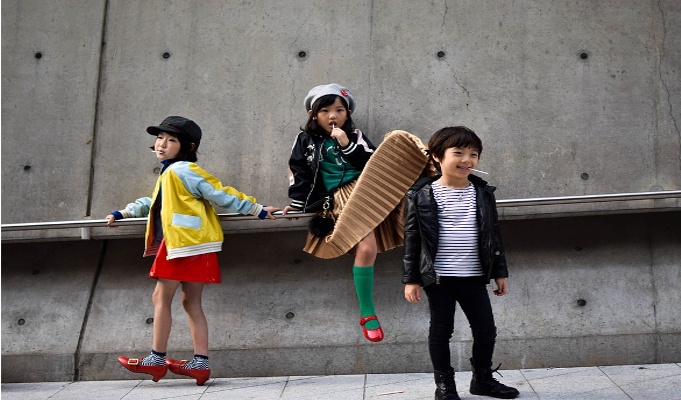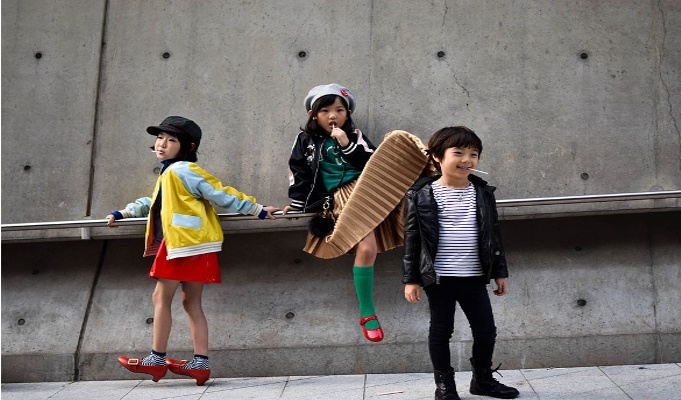
Fathom this – e-commerce marketplace fashion player Myntra has more than 400+ kidswear brands listed on their portal. Amazon has close to over 200 and Flipkart has over 2,000+ brands listed under their kidswear category! The online market for kidswear has opened up the category to an unimaginable size and thanks to this today a lot many brands have come into play. Where earlier parents would hesitate from investing in ‘brands’ for their children, today, thanks to the online market, brand consciousness in this category has grown multi-fold. From shopping for children being need-based to binge shopping just based on what appeals to the eye and the pocket, online shopping has become a game changer for kidswear.

According to Barclays, a UK based bank, kid’s fashion in India is expected to grow to $14 billion by 2020.
On the response being witnessed by the kidswear category online, Myntra shares, “Kidswear is one of the biggest emerging categories on Myntra and has witnessed rapid growth in the last two years. While our strength remains the 3-14 years apparel segment, our primary focus has been to build the infant wear and footwear business along with a few niche subcategories like ethnic wear and party wear. Kids’ casual wear is a big bet segment for us because of its perennial demand, while the popularity of ethnic wear is confined to festive seasons.”
“Recent shopping trends on Myntra have indicated that customers like to buy trend-forward labels and don’t restrict themselves by shopping from top brands only. Sportswear, led by the pre-teens, and accessories are the new categories that have immense growth potential and will be a key focus area for us this year,” Myntra adds.
To bring into perspective the performance of the kidswear category offline, one can state with confidence that the category potential is growing manifold. All malls today have a dedicated kidswear zone, with the space increasing every year.
Manoj K Agarwal, CEO, Viviana Mall says, “We have witnessed a positive growth in this category for the past 3 years at an average growth of 9 percent YoY. Optimisation of the store size is the key – The average area that kidswear retailers look at is in between 600-800 sq. ft. of carpet area. Also, the adjacencies of the category is critical. We have deliberately placed the category next to our FEC and multiplex so that the footfalls and visibility is at the optimum level. Our kids zone has brands like Mothercare, Disney Kids, UCB Kids, adidas young athletes, US Polo Kids etc.”
Changing Market Sentiments
Social media to a large extent has played a pivotal role in coaxing parents to spend on dressing their kids. It isn’t uncommon to spot parents clicking pictures of their children be it indoors or outdoors and invariably this culture of constantly being ‘ready for a picture makes one subconsciously fashion conscious. The mini-me mindset of mothers and fathers too has a considerable role in making parents spend on fashionable clothing for their children. Be it buying clothes for vacations or simply occasional wear, parents today want their children to be a reflection of themselves. But what happens when people in far flung places also want to at par with their metro peers?
The growing demand for kidswear has led to retailers trying to make sure their products are available in every corner of the country and this is where online retailing comes in – to help strengthen their retail reach in regions where companies don’t have physical presence in the form of retail outlets and stores. And the potential for online retail in kidswear is huge.
Take for example the inception story of Hopscotch.in. As the story goes, Rahul Anand – an MBA from Harvard Business School – while staying in New York met many people who specially travelled all the way to New York just to shop for their children. The trip, according to these parents, was justified keeping in mind the price points and the options that they had at their disposal while shopping for kidswear. This led Anand to conceive the idea of launching a portal that would have unique and trendy clothes for children and thus Hopscotch.in came into being.
Serving customers across 1,300 cities, team Hopscotch manages to launch hundreds of new styles every day for their target audience through a team that comprises of international designers across China.
Recently, Rahul Anand had been quoted as saying that his brand had noticed that Indian parents have become fashion seekers and are always looking for the best trends for their children – at all ages and stages of a child’s development. Citing an example from the data collected on Hopscotch, Anand said that parents dress their kids in infant fashion from when they are newborn to one year old. Between the ages of two to five, first-time parents opt to shop ‘the look’ and between ages six to nine, parents buy separate items, and are more confident about mixing and matching them.
The market sentiment for ethnic/ Indian wear is growing, with the segment witnessing good traction. Indian wear brands like BIBA have so much demand for their kidswear range that they have gone and opened exclusive BIBA Girls offline stores in addition to pushing their online sales for their collection dedicated to girls.
However, fashion and western wear have always been synonymous in India, more so in the kidswear category and especially so when it comes to Tier II and III towns and cities and this is applicable to the online market as well where portals like Hopscotch, FirstCry, Lespetits etc., concentrate heavily on kid’s western wear.
Other well-known brands which are available online include Gini & Jony, Cut Cucumber, 612 League, H&M, Lilliput, United Colors of Benetton, U.S.Polo Assn: Kids, GAP, Allen Solly Junior, Bossini, Cherokee, Nauti Nati, Marks & Spencer, Peppermint and Vitamins.
International brands like Tommy Hilfiger, M&S and Mango Kids too are seen performing well online. This accentuates the point that there is a dedicated audience which doesn’t shy away from loosening its purse strings for kids.
Fashion marketplaces like Amazon and Myntra too are introducing international kidswear brands in order to rake in discerning audiences. While rocknshop.com, litletags.com, babycourture.in and Lespetits offer designer brands including Dolce & Gabbana and Versace, Myntra announced the launch of the OshKosh B’Gosh® online store, a very reputed kidswear brand from the U.S – reiterating the fact that the market for kidswear has immense potential and has now moved beyond the ‘need’ space.
Besides the hot selling brands, the kids online market has some extremely niche players too like Greendigo that has been started by Meghna Kishore and Barkha Bhatnagar from Mumbai. The brand is a GOTS certified organic clothing brand for kids to the age of 12 years. What makes the brand niche is its USP of clothes that are not made using synthetic fibres, toxic materials and dyes apart from being capsule- wardrobe friendly (clothes that don’t go out of fashion).
Metros vs. Non-Metros
The mall culture today isn’t just restricted to Tier I cities and metros but has spilled over to Tier II and III cities and towns as well, leading to a change in the aspirational values of the shoppers there. Internet penetration throughout the country including rural India too has led to a rise in the fashion aspiration and shopping behaviours.
Young parents residing in non-metros opt to shop online for many reasons, the most widespread of which are easy availability and discounted pricing strategies adopted by online players.
On the potential being observed from non-metros, Jacqueline Kapur, Co-Founder and President – Ayesha Accessories says, “Ayesha Accessories’ online sales are approximately 10 percent of the total sales. We believe that the e-commerce market has an incredible potential for growth. With the globalisation of India and Tier II and III cities becoming more and more westernised in their fashion apparel approach the fashion jewellery category will be in demand as well. The online market gives the customer the easy access to products which might not be yet available off -line in the smaller cities. We started our sub- brand for kids accessories, Lil Star, in 2015 with a small range of products. The exceptional response of the young mothers encouraged us to enlarge the range and this financial year Lil Star accounts for approximately 25 percent of our total sale. Hair accessories are definitely leading the sub-category and the demand is only growing.”
Lil Star caters to children in the age group of 3 to 12 years. The brand offers everything a mother needs to beautify her daughter including hair accessories, jewellery, sunglasses, watches, bags, caps, hats and a few stationary items, too.
According to Kapur, when it comes to accessories, “Hair accessories and small bags are our bestsellers off as well as on-line. Prices start as low as `100 and go up to about `1,500 in the category of Lil Star.”
Siddharth Bindra, Managing Director – BIBA reveals, “People are buying through the year but being an Indian wear brand, we definitely see a spike in the festive and wedding seasons. The major challenge still remains the absence of a trial option in online. Mothers would preferably like to have their kids try out an outfit before making a purchase. Despite this we still have customers buying from BIBA. in because of our very customer friendly return and exchange policy.”
According to him, the most accepted price points for his brand range between Rs 2,000 to Rs 3,000 and the sale is lead more in by age group of 11 year old children. On the trigger that leads customers to shop online, Bindra is of the opinion that more than the designs, it is the price that attracts his target audience, “Customers shopping online are price conscious, but we maintain the price points online and offline.”
Elaborating on how the brand boosts its online sale for BIBA Girls, Bindra says, “We have given a dedicated space to BIBA Girls on the website homepage. We reach out to our target audience through e-mailers, izooto, Facebook and Google, the last two being the best mediums.”
The Future
The growth of the kidswear category online is undeniable. Whether the growth is led by social media influence, changing lifestyle of urban and rural Indians or simply by the entry of a lot many more domestic and international brands, the category is witnessing an interesting phase. Apart from marketplace e-commerce players, entrepreneurs entering the space with their exclusive and niche kidswear line are expanding the category as well. As Siddharth Bindra aptly puts it, “The online market in general will continue to grow and online market for kidswear is no exception.”


